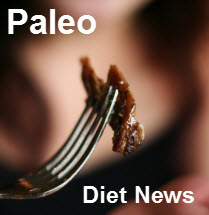Paleo Diet: Is That Loose Skin, or Just Body-Fat?
This subject is actually a large concern for a lot of people. It has concerned me in the past because…..well…I’m vain, and I didn’t relish the idea of having pieces of loose skin on my body, as I lost weight.
I was never really more than about 20lbs overweight, even at my heaviest, but after seeing all of those weight-loss shows on TV, I hoped that loose skin wouldn’t be a problem for me….especially since I was already over 30 years of age. There have been several times when I have looked in the mirror and asked myself, “Is that loose skin, or just body-fat?”
Mark Sisson was kind enough to publish an article yesterday, on his Mark’s Daily Apple blog, called “Dear Mark: Excess Skin After Major Weight Loss?” which provides some really helpful information on this subject.
“Most cases of loose skin are actually just cases of excess subcutaneous body fat covered by skin. And because subcutaneous fat is “soft” fat, it is looser and easier to confuse with skin. It droops and jiggles and the skin that surrounds it conforms to its shape. That’s not to suggest that legitimately loose skin isn’t a real problem, because it is. But I would wager that many if not most cases of loose skin can be explained by overly stubborn deposits of subcutaneous fat.”
Watch out, here comes a little technical geekiness! This is great info though, and it makes a lot of sense…
“Stubborn fat is actually a real thing. As Martin Berkhan explains, adipose tissue is full of alpha-2 and beta-2 receptors. A-2 and b-2 receptors are the major lipolytic receptors in adipose tissue, meaning they interact with the catecholamines (adrenaline and noradrenaline) to cause stored body fat to release. B-2 receptors are associated with “easy fat,” or fat that burns off easily. A-2 receptors are associated with “stubborn fat,” or fat that’s harder to burn. All adipose tissue has both a-2 and b-2 receptors, and the higher the b-2:a-2 ratio, the easier it is to burn the fat. The lower the ratio, the more stubborn the fat. Belly fat has a notoriously low b-2:a-2 ratio, which is why it’s usually the last to go (especially for men). If your belly fat is stubborn, it may resemble loose skin even as the rest of your body has mostly leaned out.”
I’ve personally ALWAYS struggled with stubborn belly fat. Even when my body fat was down in the high-single digits, my stomach never seemed to be as lean as it should have been. I blame the majority of this on the cortisol, adrenaline, and estrogen that seem to be resultant from staying really low-carb for a really long time.
“If your loose skin is thicker than a few millimeters, there is residual body fat. And because adipose tissue – which, remember, is actually a major endocrine organ, rather than an inert piece of tissue – remains, the skin has no reason to return to its former size and elasticity. As long as the subcutaneous fat attached to it remains, the skin will appear loose and drape-y. Skin that fills your hand when you squeeze it isn’t just skin.
This isn’t really bad news, believe it or not. It actually means that you’re almost there. It means that your “loose skin” isn’t necessarily out of your control. If indeed it is simply stubborn subcutaneous fat, once you manage to lose the excess fat, the “loose skin” might just disappear along with it. In fact, I’d imagine that most such cases of “loose skin” can and will be remedied in this manner. Men, get down to around 10-12% body fat before you start considering surgery or anything drastic. Women, get down to 15-17% body fat before taking any surgical steps.”
Mark goes on to talk about Dr. Ron Brown, who believes that loose skin is a myth. Here’s a chunk of text from Dr. Brown’s website:
“The human integumentary system (skin) is not a passive layer of tissue that remains stretched out like an empty plastic bag after losing large amounts of bodyweight. The argument of the woman above about the cause of loose skin is a myth. Rather, skin is a living organ, actively adapting to the body’s internal and external environments. People on extended fasts consuming nothing more than water have demonstrated that the skin can lose 20% or more of its size.
The skin is usually thickest on the soles of the feet, and thinnest on the eyelids. As a typical example of your skin’s thickness, pinch the skin on the back of your hand. If it were true, as this woman claims, that the folds of skin hanging off her body had absolutely no fat left underneath to diet away, every inch of this skin would hang in sheets as thin as folds of paper.
However, common observation of the folds of skin in such examples reveals this is not usually the case. Measuring the thickness of these hanging folds of skin provides evidence that there is still a substantial amount of body fat underneath the skin. The skin is not so much “loose” as it is flabby due to excess body fat. Even if some areas have completely thinned out, excess body fat is likely to be stored in adjacent areas that contribute to the overall flabby condition.
Age is claimed to be a factor that reduces skin elasticity and thus reduces the ability of the skin to readjust it’s size after weight loss. However, many cases of loose skin are found in relatively young people who have lost weight, so the effect of age on skin elasticity is not really a factor in all cases, if at all.” – Dr. Brown
Okay, back to Mark…
“That said, if your loose skin is paper thin, closer to the thickness of your eyelid or the back of your hand (about 1 mm thick), and resembles rolled up papyrus or parchment, you likely suffer from excess skin. What can be done to prevent or deal with actual excess skin?”
“First and foremost, any weight loss regimen must be accompanied by resistance training. Yeah, I’ve said it before, and I’ll say it again: you have to be lifting heavy things in order for the best things to happen to your body composition.”
I’m pretty sure Ken O’Neil will appreciate that one!
“Another major cause of loose skin is compromised skin elasticity. If your skin loses elasticity, it will lose its ability to spring back to its former glory. Lost elasticity is usually thought of as a characteristic of growing old, but it can also strike younger people. Besides finding the fountain of youth, what can you do to improve skin elasticity?
One study found that dietary gelatin improved skin elasticity (PDF). Eating real bone broth, fatty gelatin-rich meats like oxtail, poultry feet, or short ribs, or even using gelatin powder as a supplement might be able to restore or preserve skin elasticity. You’re already getting dietary gelatin anyway, right?”
Dr. Ray Peat is big proponent for the use of Great lakes grass-fed Gelatin powder as a daily dietary supplement, for this reason and several more.
“Another study found that a proprietary blend of nutrients, including selenium (salmon, Brazil nuts, seafood), zinc (oysters, red meat), vitamin C (vegetables, fruit, raw liver), and various carotenoids (fruits and vegetables, red palm oil), was effective at increasing skin elasticity.
Vitamin C is important for collagen formation, which is vital for skin elasticity. Make sure to get enough vitamin C.
If weight loss occurs and you’re at a low-enough body fat percentage to determine that you truly have excess skin, give it several months before you turn to the scalpel. My guess is that for Primal eaters who are eating a nutrient-dense diet (including plenty of the aforementioned nutrients), truly excess skin won’t be as big a problem as it might be for the general dieter.”
I take this as great news. I think Mark really hit the nail on the head, in that people are really concerned about this problem, maybe more so than many others might think. Generally speaking, when people take the plunge and decide to change their lives by loosing a substantial amount of weight, many of them look at examples of fit, tight bodies for motivation…..I’m not saying everyone does, but I certainly did!
How must it feel for someone to loose a bunch of weight, like 100lbs plus, only to be left with some unsightly excess skin? I can see where it could be a huge disappointment or roadblock for someone. It’s good to know that many people should be able to get rid of their “loose skin”, simply by reaching a lower level of body fat…..but surgery may still be the only option for some.
Is that loose skin, or just body-fat?
Regardless, before you even consider surgery, there are several dietary strategies for you to try, if you want to shave off those last few pounds and break into the lower levels of the body-fat percentage. A cyclic ketogenic diet, targeted ketogenic diet, or intermittent fasting are but a few of the possible weight-loss solutions that could get you where you want to be. Give me a call, and I’ll get you on the right track…..I am a weight-loss consultant, you know!
Do you have loose skin after having lost a lot of weight? What have you tried to remedy the situation? If you found this article useful, please click
the ‘LIKE’ button below to share on Facebook. Also send a tweet or two! We also invite you to leave comments, and join the Paleo Diet News discussion!
Go to www.undergroundnutritionist.com, and download my 30-Day UN-Challenge eBook now……It’s a step-by-step guide to your personal health revolution.
Barry Cripps is a Paleo-based, Certified Nutrition and Wellness Consultant, who operates out of Bowling Green, Kentucky.
For more information please visit: www.undergroundnutritionist.com






This message gives me a lot of hope. I’ve lost 50 pounds so far with 40 more to go. I was really worried about “loose skin” as I lose the additional 40 pounds. Now I’m motivated even more to get rid of the stubborn fat and continue weight lifting as one of my tactics. Thanks for this very informative post. Just what I needed.
You and me both, Vicki! I also have a lot to lose and was concerned about skin. I’m thrilled that Barry wrote it!
Thanks for commenting!